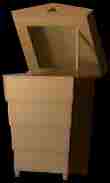



The notion of collective behaviour has been extensively studied with regard to the way that superorganisms (large groups of creatures) swarm, move in schools and flock. The behaviour of the superorganism (the swarm) is seen as emerging from the mass of individual insects (or indeed artificial life-forms housed on a computer).
Hive mind approaches physics and biology in a way which reconciles both a reductionist reduce-it-to-its-parts approach with the see-it-as-a-whole approach, the duality of body/mind or whole/part evaporates when holistic behaviour emerges from the limited behaviour of the parts.
Interestingly there is a current view of cognitive science which suggests that human memory is constructed in a way similar to the swarm, from piecing together fragments which are distributed throughout the brain.
The SWARM Installation takes these ideas as a starting point, using the honeybee as a reference and interweaving images and sounds of swarms and individual bees with images from countryside and towns. Sounds of traffic, bees and interviews with people are used in fragments to invoke the social swarming of humans as well as the swarming of insects. Video shoots would include an afternoon with a beekeeper.
The installation uses the materials of computer hardware, hives and honey. There are 3 larger than life-sized hives laid out in the gallery, on first sight these appear normal garden hives, but on closer inspection it is clear that they have been treated so that they have the plastic-coated surface associated with computers. Each hive houses images in a different way.
Images captured on video and combined with texts and digital animationsused to produce a single tape piece which will be housed in an open-topped bee-hive, with the monitor visible when the viewer looks down on the hive.
The second bee-hive features images from an artificial algorithmic swarm housed on a PC (which is stored in the bee-hive). Moving images of three swarms are projected out of the hive and onto the wall or ceiling. The swarm moves in real-time across the ceiling and will swarm follow visitors to the space, tracking them via pressure pads.
The third hive contains 5 projection screens, displayed so that they resemble honeycomb racks. Gallery visitors can interact with the screens to trigger small interactive sequences which show various locations and are accompanied by quotes from residents of Uley.
Swarming soundshave been developed from samples taken from bees and people and treated to form swarming `clouds' of sound which seem to move around the gallery. Thsound has been developed in conjunction with Justin Bennett, a composer working in Holland.
The final component of the installation is a wall made up of of jars honey illuminated from behind.